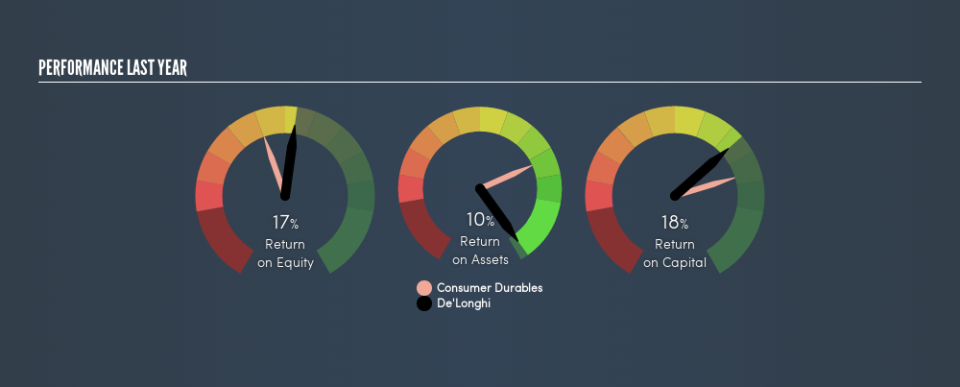A Close Look At De’Longhi S.p.A.’s (BIT:DLG) 18% ROCE

Want to participate in a research study? Help shape the future of investing tools and earn a $60 gift card!
Today we’ll evaluate De’Longhi S.p.A. (BIT:DLG) to determine whether it could have potential as an investment idea. To be precise, we’ll consider its Return On Capital Employed (ROCE), as that will inform our view of the quality of the business.
First of all, we’ll work out how to calculate ROCE. Next, we’ll compare it to others in its industry. Last but not least, we’ll look at what impact its current liabilities have on its ROCE.
What is Return On Capital Employed (ROCE)?
ROCE measures the amount of pre-tax profits a company can generate from the capital employed in its business. In general, businesses with a higher ROCE are usually better quality. Overall, it is a valuable metric that has its flaws. Renowned investment researcher Michael Mauboussin has suggested that a high ROCE can indicate that ‘one dollar invested in the company generates value of more than one dollar’.
So, How Do We Calculate ROCE?
Analysts use this formula to calculate return on capital employed:
Return on Capital Employed = Earnings Before Interest and Tax (EBIT) ÷ (Total Assets – Current Liabilities)
Or for De’Longhi:
0.18 = €251m ÷ (€2.1b – €668m) (Based on the trailing twelve months to December 2018.)
So, De’Longhi has an ROCE of 18%.
See our latest analysis for De’Longhi
Is De’Longhi’s ROCE Good?
One way to assess ROCE is to compare similar companies. Using our data, we find that De’Longhi’s ROCE is meaningfully better than the 14% average in the Consumer Durables industry. I think that’s good to see, since it implies the company is better than other companies at making the most of its capital. Regardless of where De’Longhi sits next to its industry, its ROCE in absolute terms appears satisfactory, and this company could be worth a closer look.
Remember that this metric is backwards looking – it shows what has happened in the past, and does not accurately predict the future. ROCE can be misleading for companies in cyclical industries, with returns looking impressive during the boom times, but very weak during the busts. ROCE is, after all, simply a snap shot of a single year. Since the future is so important for investors, you should check out our free report on analyst forecasts for De’Longhi.
What Are Current Liabilities, And How Do They Affect De’Longhi’s ROCE?
Liabilities, such as supplier bills and bank overdrafts, are referred to as current liabilities if they need to be paid within 12 months. Due to the way ROCE is calculated, a high level of current liabilities makes a company look as though it has less capital employed, and thus can (sometimes unfairly) boost the ROCE. To counter this, investors can check if a company has high current liabilities relative to total assets.
De’Longhi has total assets of €2.1b and current liabilities of €668m. As a result, its current liabilities are equal to approximately 32% of its total assets. De’Longhi has a medium level of current liabilities, which would boost the ROCE.
What We Can Learn From De’Longhi’s ROCE
De’Longhi’s ROCE does look good, but the level of current liabilities also contribute to that. You might be able to find a better buy than De’Longhi. If you want a selection of possible winners, check out this free list of interesting companies that trade on a P/E below 20 (but have proven they can grow earnings).
If you like to buy stocks alongside management, then you might just love this free list of companies. (Hint: insiders have been buying them).
We aim to bring you long-term focused research analysis driven by fundamental data. Note that our analysis may not factor in the latest price-sensitive company announcements or qualitative material.
If you spot an error that warrants correction, please contact the editor at editorial-team@simplywallst.com. This article by Simply Wall St is general in nature. It does not constitute a recommendation to buy or sell any stock, and does not take account of your objectives, or your financial situation. Simply Wall St has no position in the stocks mentioned. Thank you for reading.

